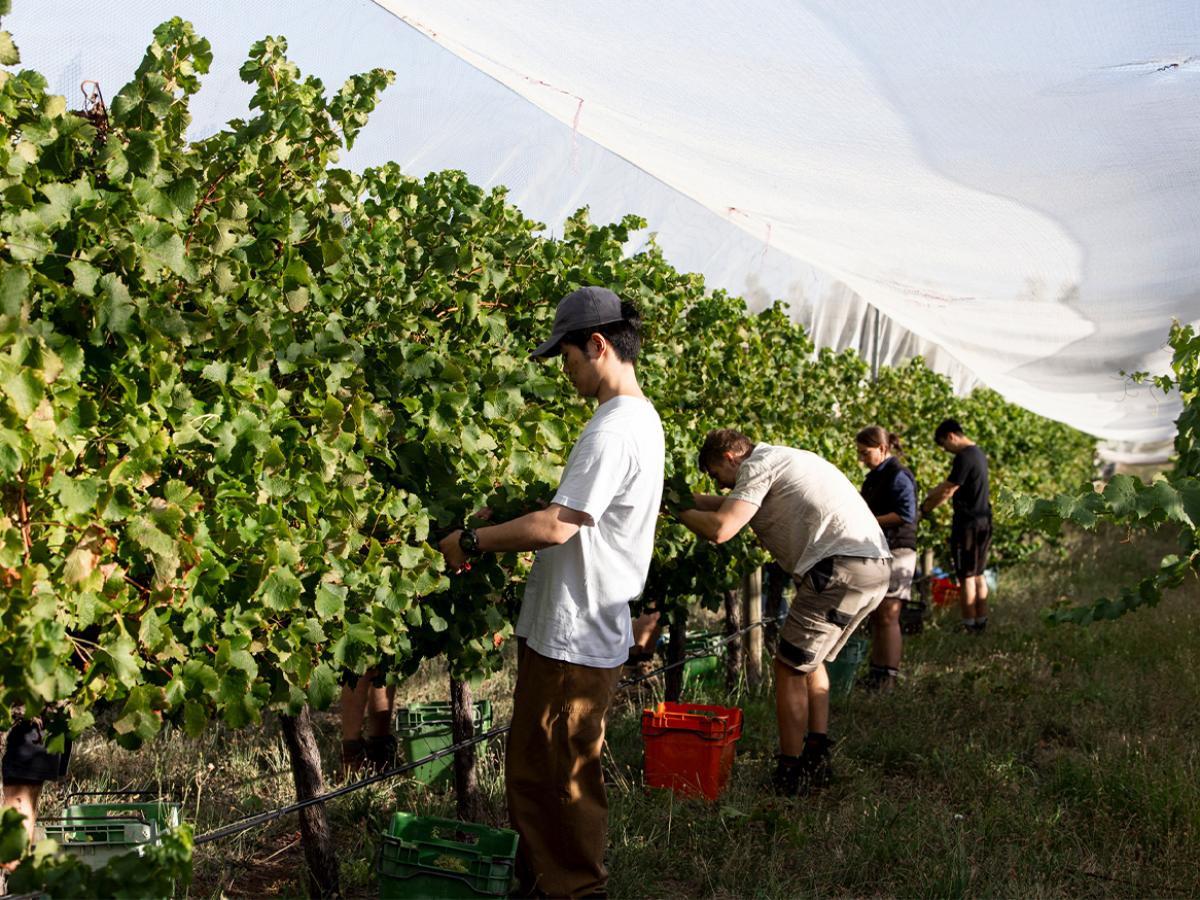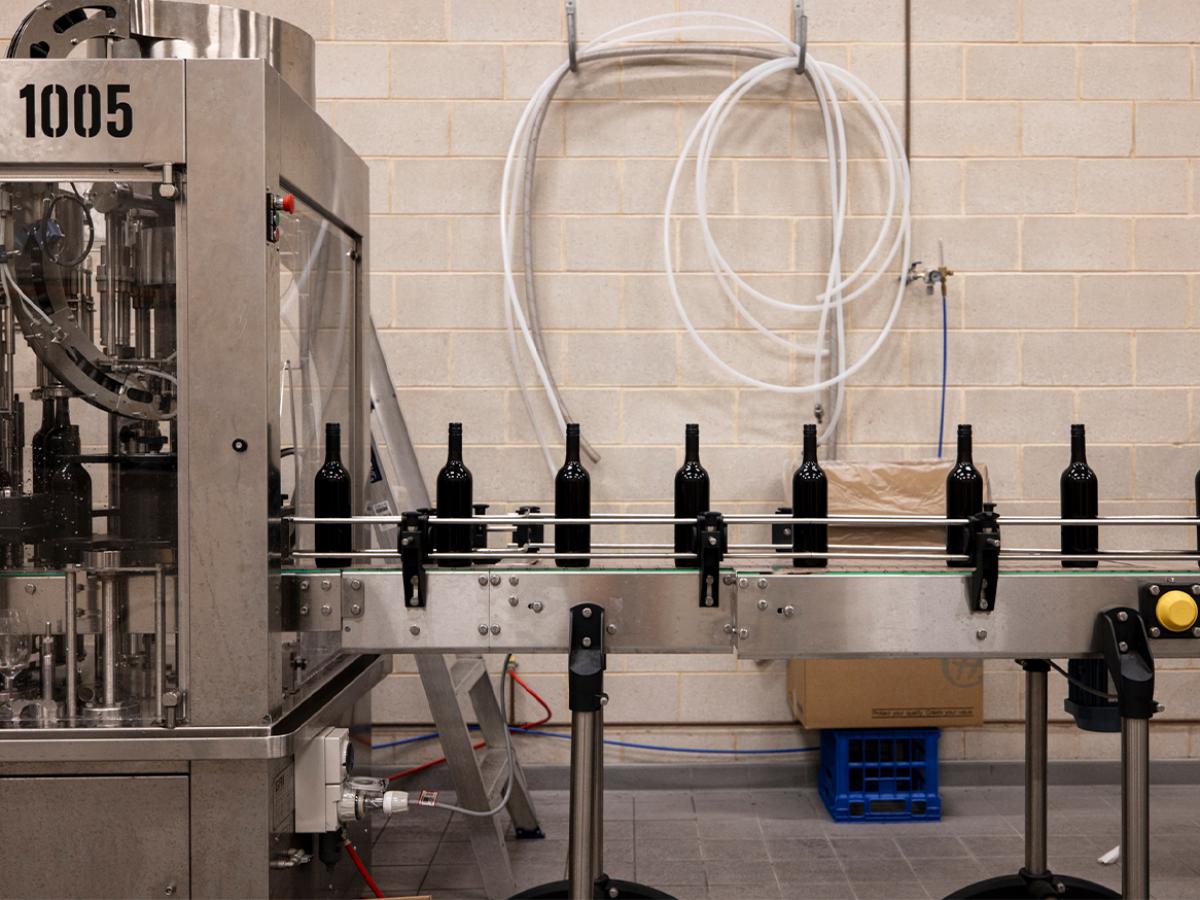Harvesting knowledge
Harvest is a crucial part of every winemaker and viticulturist’s year. Meet the team of staff and students who tackled the 2024 vintage at Waite.

It’s 7am on a Wednesday and quiet chatter can be heard emanating from the Waite campus’s Coombe Vineyard. It’s harvest time and the anticipation is audible.
A group of third-year and postgraduate Viticulture and Oenology students are onsite, carefully picking Semillon. Confident hands make deft work of snips, dropping bunches of grapes into buckets as they meticulously move through the rows. Some of these bunched beauties are destined to make their way into brandy, others into wine.
The one-and-a-half-hectare vineyard is home to a mix of varieties, each handpicked by students when the time is right. Mother Nature calls the shots but, fortunately, today is relatively mild and the students have been hard at work for hours.
Jill Bauer, a Lecturer and Senior Winemaker at Waite, is here to oversee proceedings. She says there’s no time like vintage. “It’s always exciting,” Jill says. “I love the hope and the enterprise that vintage brings.”
When the fruit is picked, it makes its way to the winery, where students are split into groups of four to turn their designated variety into wine. There’s plenty on offer.
The Waite vineyard is primarily home to reds, including Shiraz, Grenache and Mataro. There’s also Tempranillo, Merlot, Cabernet Sauvignon, Touriga, and Tinta Armarela.
Whites such as Chardonnay, Riesling, Sauvignon Blanc and Semillon are also grown here, along with a small block home to a “fruit salad” of 30-plus varieties.
“We are working on assessing what we have in our versatile mix and are planting some more emerging varieties, like Barbera, Fiano, and Sangiovese,” says Jill. What can’t be picked onsite is sourced from growers in regions including McLaren Vale, Clare Valley, Adelaide Hills, Barossa Valley, and Langhorne Creek. “The fruit that we source from off campus offers diversity,” she says.
With the excitement of harvest, though, comes trepidation – especially so at the Waite winery, says Jill.
“Most wineries don’t have 60 to 80 new young winemakers coming in to work on their cellar floor,” she says. “It’s a bit like having 80 people come into your house to stay for a while.”
Such mixed emotions are normal.

“I think any winemaker feels that,” Jill says. “There’s so much on the line. The season and the weather are out of your control and you can’t predict a lot of what happens. Here, you have the added complexity of dozens of different people in the building – whether it’s researchers, students, academics, growers or customers. It makes for many different push-pull personalities.”
Practical experience, like the kind offered in the vineyard today, is essential for producing well-rounded students and future winemakers.
“I believe it is everything,” Jill says. “We’re all down here getting our hands dirty. I’m just as likely to be sweeping the floor and shovelling grapes as I will be cleaning out a press. Students need to see how hands on it is especially in small batch fermentations.”
A diverse crew of international and local students adds to the excitement. Students from Canada, Belgium, Netherlands, US, China, Taiwan, and Hong Kong work together in classrooms, the vineyard, and the winery. Among them is Delphine Derache, who moved from her homeland of Belgium to enrol in a Master of Viticulture and Oenology at the University of Adelaide.
“It is a very internationally renowned program,” Delphine says. “My family was always interested in wine, and we went to a lot of wineries across Europe. Previously, I studied Bioscience Engineering (at the Catholic University of Leuven, Belgium), and when I told my parents about this program in Australia they said, ‘go for it’.”
It’s all hands-on deck, from gathering samples for analysis with Associate Lecturer and Vineyard Manager Benjamin Pike and Associate Professor Cassandra Collins, to winemaking duties.

“We help each other out,” Delphine says. “Our group of four has a Clare Valley Riesling which comes into the winery, and we’re also doing a red, a Bordeaux blend of five varieties.”
Meanwhile, Dutch student Jip van Es has been in Australia for five years, working as a cellar hand at wineries, including Bellwether Wines on South Australia’s Limestone Coast.
“I’ve worked in the wine industry across different regions and didn’t want to be a cellar hand for the rest of my life,” she says. “I was very interested in the chemistry behind winemaking, and this is great because we’re learning every aspect of the process.”
They don’t all have lofty career aspirations. Local Adelaide student David Sleath is here to explore a new chapter.
“This is a later in life, career change for me,” he says.
“I wanted to do something different to occupy a few years until retirement. I had two previous careers and thought I had one more in me. Something more fun this time. It’s a great group of people; they are a really committed, approachable, and friendly group. It’s a lovely environment to learn in.”
Professor of Oenology Kerry Wilkinson loves the diversity of students.
“Even at the post-grad level, we’ll have a mix of people who’ve worked in the wine industry for a long time but don’t have a formal qualification, so they’ve decided that they want to get that qualification,” Kerry says. “It can be quite diverse, so we try to cater to those needs and also provide additional resources to support students who are starting from a lower level and need a bit more help.”

Kerry says a “scaffold” approach to learning is important. Students spend their first year or two learning basic grape analysis, variety identification, microbiology, sensory science, biochemistry, and viticulture before they hit the winery and complete a vintage. Once they reach that stage, Bauer is a fan of highlighting the “art” of the process.
“You can’t just be a scientist and use that lens, you have to be able to use winemaking as an expression of yourself,” she says. “Other schools have technology that allows students to program pump-overs and temperatures. Soon, there will be ‘electronic noses’ that detect things for you, and that’s great on some level, but if you don’t know what you’re looking for, how are you ever going to be able to calibrate that?
“We are incredibly hands on and that’s a legacy of the Roseworthy program. I think that’s what differentiates our program from anywhere else in the world – the fact that we effectively give students two tonnes of fruit with which to make wine, and with no commercial realities to hold them back.”
At the end of the process, students hopefully have a wine to purchase and proudly share with friends and family.
“It’s a reason to work harder,” Jill says. “They also have to present it to everyone and discuss what went well and what didn’t go so well. We try to keep ourselves out of the process as much as possible, to let them make decisions.”
Jill believes strongly in embracing a growth mindset.
“Failures are okay in the learning process, because if you make a mistake, you’re going to learn how to fix it,” she says. “Students who make seemingly fatal errors with their wine are going to learn the most. You’re never going to forget that error and when you go into a commercial setting, you’re going to understand how to fix it.”
Written by Katie Spain
Photography by Kelsey Zafiridis
